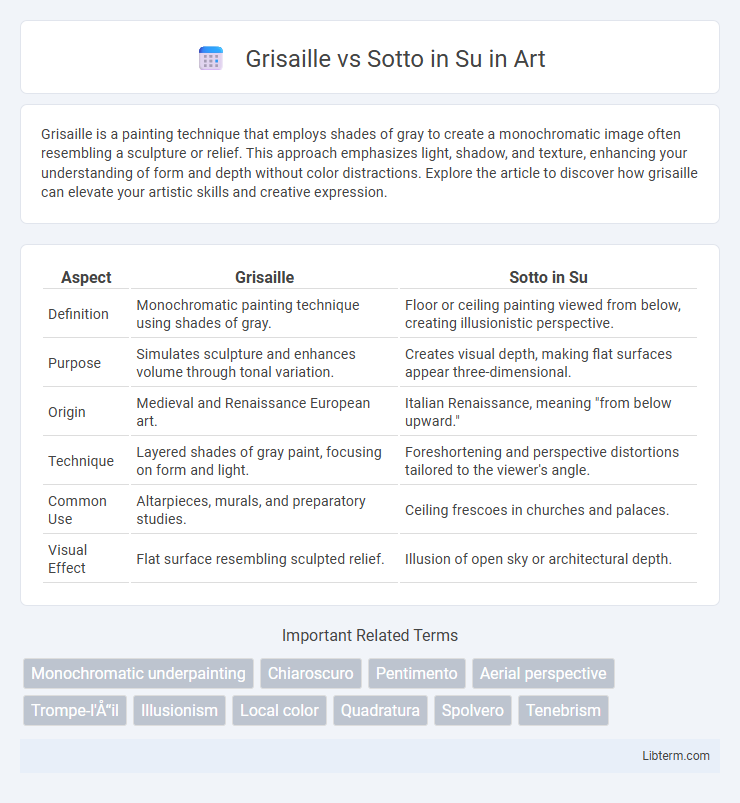Grisaille is a painting technique that employs shades of gray to create a monochromatic image often resembling a sculpture or relief. This approach emphasizes light, shadow, and texture, enhancing your understanding of form and depth without color distractions. Explore the article to discover how grisaille can elevate your artistic skills and creative expression.
Table of Comparison
| Aspect | Grisaille | Sotto in Su |
|---|---|---|
| Definition | Monochromatic painting technique using shades of gray. | Floor or ceiling painting viewed from below, creating illusionistic perspective. |
| Purpose | Simulates sculpture and enhances volume through tonal variation. | Creates visual depth, making flat surfaces appear three-dimensional. |
| Origin | Medieval and Renaissance European art. | Italian Renaissance, meaning "from below upward." |
| Technique | Layered shades of gray paint, focusing on form and light. | Foreshortening and perspective distortions tailored to the viewer's angle. |
| Common Use | Altarpieces, murals, and preparatory studies. | Ceiling frescoes in churches and palaces. |
| Visual Effect | Flat surface resembling sculpted relief. | Illusion of open sky or architectural depth. |
Introduction to Grisaille and Sotto in Su
Grisaille is a painting technique that employs various shades of gray to create a monochromatic image, often mimicking sculpture or relief. Sotto in Su is a fresco method painted on ceilings or high surfaces, designed to be viewed from below, enhancing the illusion of three dimensions. Both techniques emphasize depth and realism, with Grisaille focusing on tonal contrast and Sotto in Su on perspective and viewer angle.
Historical Origins of Grisaille
Grisaille, a painting technique using shades of gray to create the illusion of sculpture, originated in Northern Europe during the 14th century, particularly in Gothic cathedrals and illuminated manuscripts. This method was employed to mimic stone reliefs, enhancing architectural elements without the expense of actual sculpture. In contrast, Sotto in Su, an Italian Renaissance technique, emerged in the 16th century to create dramatic ceiling frescoes with extreme foreshortening and illusionistic perspectives.
Historical Development of Sotto in Su
Sotto in Su, an Italian term meaning "seen from below," originated during the Renaissance period as a technique for ceiling frescoes that create an illusion of three-dimensionality by depicting figures and architectural elements foreshortened from the viewer's perspective. Unlike Grisaille, which uses monochromatic grays to imitate sculptural reliefs, Sotto in Su employs vibrant colors and dramatic foreshortening to enhance the immersive experience in monumental interiors such as churches and palaces. This artistic development evolved through masters like Andrea Mantegna and Correggio, who innovated spatial perception and narrative depth in ceiling paintings, establishing a dynamic visual dialogue between art and architecture.
Techniques Used in Grisaille Painting
Grisaille painting in Su employs monochromatic shades of gray to create intricate depth and volume, emphasizing light and shadow rather than color. This technique involves layering thin washes of gray pigment to build subtle details and achieve a sculptural effect reminiscent of bas-relief. Mastery of brush control and tonal gradation is essential for achieving the smooth transitions and fine textures characteristic of Grisaille.
Techniques and Perspectives of Sotto in Su
Sotto in Su is a ceiling painting technique that employs extreme foreshortening to create the illusion of three-dimensional space viewed from below, enhancing depth perception and spatial realism. Grisaille, in contrast, uses monochromatic tones to simulate sculptural relief, emphasizing volume through shading rather than perspective distortion. The Sotto in Su method focuses on dynamic perspective and dramatic angles, transforming flat surfaces into immersive, architecturally integrated scenes.
Notable Artists in Grisaille Tradition
Notable artists in the grisaille tradition include Jan van Eyck, whose intricate monochromatic works set a high standard during the early Northern Renaissance, and Piero della Francesca, known for his mastery in depicting volume and light using shades of gray. Gerard David and Hans Memling also contributed significantly, enhancing religious and secular imagery with refined grayscale techniques. These artists emphasized the dramatic interplay of form and shadow, showcasing grisaille as a sophisticated alternative to full-color painting.
Masterpieces Featuring Sotto in Su
Masterpieces featuring Sotto in Su showcase intricate three-dimensional ceiling paintings that create the illusion of architectural depth, elevating the perception of interior spaces with remarkable realism. Grisaille, by contrast, uses monochromatic tones to simulate sculptural relief, emphasizing texture and form over spatial illusion. Sotto in Su artworks by artists like Andrea Mantegna and Paolo Veronese highlight the technique's ability to transform flat ceilings into expansive, sky-like vistas, making them iconic in Renaissance and Baroque art.
Artistic Purposes and Effects in Both Styles
Grisaille employs monochromatic shades of gray to create sculptural depth and illusionistic volume, emphasizing form and shadow over color, which enhances the perception of three-dimensionality in artwork. Sotto in su, an Italian term meaning "from below upwards," utilizes dramatic foreshortening and vibrant colors on ceilings to create immersive, soaring perspectives that extend architectural space. Both styles serve distinct artistic purposes: grisaille offers a subtle, refined depth often used in underpainting or decorative panels, while sotto in su provides dynamic, illusionistic effects that engage viewers in a spatially transformative experience.
Comparing Visual Impact: Grisaille vs Sotto in Su
Grisaille in Su creates a monochromatic, muted visual impact that emphasizes texture and form through shades of gray, enhancing depth and subtlety in the composition. Sotto, by contrast, utilizes vibrant colors and dynamic contrasts, generating a more vivid and attention-grabbing effect that highlights specific elements within the artwork. Comparing Grisaille and Sotto in Su reveals distinct approaches to visual storytelling: Grisaille relies on tonal variation and restraint, while Sotto leverages chromatic intensity and boldness.
Contemporary Applications and Revival
Grisaille and Sotto in Su techniques in contemporary art leverage their historical roots to create depth and realism through monochromatic palettes and foreshortened perspectives, respectively. Artists revive Grisaille to emphasize form and shadow, often integrating it into mixed media and digital installations for a modern tactile experience. Sotto in Su is gaining traction in architectural murals and immersive environments, enhancing spatial illusions and viewer engagement in public and commercial spaces.
Grisaille Infographic

 libterm.com
libterm.com